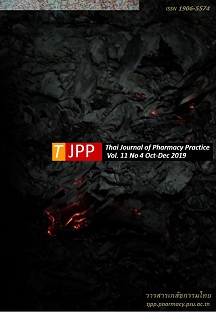ความเหมาะสมและรูปแบบของการได้รับยาปฏิชีวนะในผู้ป่วย โรคคอหอยอักเสบเฉียบพลัน ณ โรงพยาบาลระดับทุติยภูมิแห่งหนึ่ง
Main Article Content
บทคัดย่อ
วัตถุประสงค์: เพื่อศึกษาความเหมาะสมและรูปแบบการได้รับยาปฏิชีวนะในผู้ป่วยโรคคอหอยอักเสบเฉียบพลันโดยใช้ Centor criteria วิธีการ: ผู้วิจัยสืบค้นข้อมูลผู้ป่วยที่ได้รับการวินิจฉัยว่าเป็นโรคคอหอยอักเสบเฉียบพลันและมารับการรักษาระหว่างวันที่ 1 มกราคม-30 มิถุนายน พ.ศ. 2560 จากฐานข้อมูลในแผนกผู้ป่วยนอกของโรงพยาบาลระดับทุติยภูมิแห่งหนึ่ง ผู้วิจัยประเมินความเหมาะสมในการได้รับยาปฏิชีวนะด้วยเกณฑ์ของ Centor ผลการวิจัย: ผู้ป่วยทั้งหมดจำนวน 346 ราย ได้รับยาปฏิชีวนะ 304 ราย (ร้อยละ 87.9) การสั่งใช้ยาในผู้ป่วย 9 ราย (ร้อยละ 3.0) มีความเหมาะสม ผู้ป่วยที่ไม่ได้รับยาปฏิชีวนะมี 42 ราย (ร้อยละ 12.1) พบผู้ป่วย 41 รายเมื่อประเมินแล้วไม่จำเป็นต้องได้รับยา (ร้อยละ 97.6) ส่วนอีก 1 ราย (ร้อยละ 2.4) จำเป็นต้องได้รับยาแต่ไม่ได้รับยา ยาปฏิชีวนะที่มีการสั่งใช้มากที่สุด คือ amoxicillin รูปแบบของการสั่งใช้ที่พบมากที่สุด คือ amoxicillin ขนาด 500 มิลลิกรัม รับประทานครั้งละ 2 แคปซูล วันละ 2 ครั้ง ระยะเวลา 5 วัน ไม่มีผู้ป่วยรายใดได้รับยาขนาด 1,000 มิลลิกรัมต่อวันตามแนวทางการรักษา สรุป: ผู้ป่วยโรคคอหอยอักเสบเฉียบพลันของโรงพยาบาลมากกว่าร้อยละ 90 ไม่จำเป็นต้องได้รับยาปฏิชีวนะ การศึกษาพบรูปแบบการใช้ยาปฏิชีวนะที่ไม่เหมาะสมตามแนวทางการรักษาทั้งในด้านขนาดและระยะเวลาในการรักษา ซึ่งอาจกระทบต่อผลลัพธ์การรักษา ก่อให้เกิดอาการไม่พึงประสงค์จากการใช้ยา และเพิ่มโอกาสในการเกิดเชื้อดื้อยาได้
Article Details
ผลการวิจัยและความคิดเห็นที่ปรากฏในบทความถือเป็นความคิดเห็นและอยู่ในความรับผิดชอบของผู้นิพนธ์ มิใช่ความเห็นหรือความรับผิดชอบของกองบรรณาธิการ หรือคณะเภสัชศาสตร์ มหาวิทยาลัยสงขลานครินทร์ ทั้งนี้ไม่รวมความผิดพลาดอันเกิดจากการพิมพ์ บทความที่ได้รับการเผยแพร่โดยวารสารเภสัชกรรมไทยถือเป็นสิทธิ์ของวารสารฯ
เอกสารอ้างอิง
2. Choby BA. Diagnosis and treatment of streptococcal pharyngitis. Am Fam Physician 2009;79:383-90.
3. Chongtrakul P. Antibiotics smart use. 2nd ed. Bang kok: Graphic and design; 2011.
4. Centor RM, Witherspoon JM, Dalton HP, Brody CE , Link K. The diagnosis of strep throat in adults in the emergency room. Med Decis Making 1981; 1: 239-46.
5. Pelucchi C, Grigoryan L, Galeone C, Esposito S, Huovinen P, Little P, et al. Guideline for the mana- gement of acute sore throat. Clin Microbiol Infect 2012; 18: 1-28.
6. Fine AM, Nizet V, Mandl KD. Large-scale validation of the Centor and McIsaac scores to predict group A Streptococcal Pharyngitis. Arch Intern Med 2012 ; 172: 847–52.
7. Saengcharoen W, Lerkiatbundit S. Sore throat from acute pharyngitis. Thai Pharm Health Sci J 2012; 7: 52-9.
8. Sub-Committee on Rational Drug Use Promotion. Rational drug use hospital manual. Bangkok: Agri cultural Cooperatives of Thailand Printing; 2015.
9. Uruekoran R, Phonsena W, Thongdang, Somsaard P, Chaiyasong S, Srisilp T. Treatment outcome and cost of rationale antibiotic use implementation in Mahasarakham University Pharmacy. Isan Journal of Pharmaceutical Sciences 2013;9:31-42.
10. McIsaac WJ, White D, Tannenbaum D, Low DE. A clinical score to reduce unnecessary antibiotic use in patients with sore throat. CMAJ 1998;158:75–83
11. Palla AH, Khan RA, Gilani AH, Marra F. Over prescription of antibiotics for adult pharyngitis is prevalent in developing countries but can be reduced using McIsaac modification of Centor scores: a cross-sectional study. BMC Pulm Med 2012; 12: 1-7
12. Yuniar CT, Anggadiredja K, Islamiyah AN. Evalu- ation of rational drug use for acute pharynxgitis associated with the incidence and prevalence of the disease at two community health centers in Indonesia. Sci Pharm 2017; 85: 1-10.
13. Acerra JR. Pharyngitis [online]. 2018 [cited Jan 9, 2018]. Available from: emedicine.medscape.com/ article/764304-clinical
14. Casey JR, Pichichero ME. Meta-analysis of short course antibiotic treatment for group a streptococ cal tonsillopharyngitis. Pediatr Infect Dis J 2005; 24: 909-17.
15. Cohen R. Defining the optimum treatment regimen for azithromycin in acute tonsillopharyngitis. Pediatr Infect Dis J 2004;23:S129-34.
16. Seppala H, Nissinen A, Jarvinen H, et al. Resist- ance to erythromycin in group A streptococci. N Engl J Med 1992;326:292–7.
17. Tanz RR, Shulman ST, Shortridge VD, et al. Community-based surveillance in the united states of macrolide-resistant pediatric pharyngeal group A streptococci during 3 respiratory disease seasons. Clin Infect Dis 2004;39:1794–801.
18. Jasir A, Tanna A, Noorani A, Mirsalehian A, Efstratiou A, Schalen C. High rate of tetracycline resistance in Streptococcus pyogenes in Iran: an epidemiological study. J Clin Microbiol 2000; 38: 2103-7.


